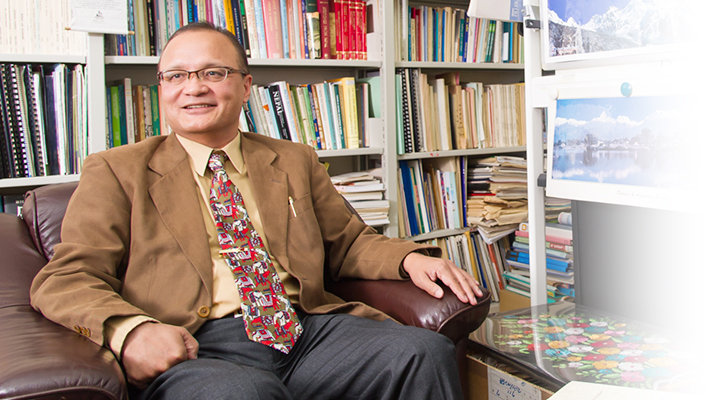
INTERVIEW
Research on rural economics and development
that will enable sustainable rural societies
What are the measures necessary
for modern technology to improve
the various inconveniences
inherent in disadvantaged areas?
Cultural Creation Course
Graduate School of Humanities and Social Sciences
Prof. Keshav Lall Maharjan
Research on rural economics and development
that will enable sustainable rural societies
Exploring measures to resolve issues faced by rural areas based on rural economics

Professor Maharjan conducts research on rural areas in developing countries with focuses on issues including rural development, agricultural economics and livelihood improvement in rural areas,
He continues his empirical researching style that places particular importance on fieldwork for rural areas based on agricultural and forestry economics, his original subject of study.
Before receiving his Master’s degree, Professor Maharjan conducted field surveys in Shiga Prefecture and made empirical analysis on how theories and practices can be utilized for the analysis of agricultural management and farm economics and their improvement, based on his learnings from interviews and participatory observations he made while living in an actual farm household, together with monitoring and practicing of farm bookkeeping (single-entry bookkeeping) of cooperating farmers during his undergraduate years in Kyoto Prefecture, During his doctoral course, Professor Maharjan studied on rural development in Bangladesh as an application of his earlier studies and also participated in JICA rural development survey projects to conduct current-state analysis of the farm economy and rural society.
After joining Hiroshima University as a research associate (assistant professor), he expanded his studies to additional countries including Nepal, India, Indonesia, and so on, and advanced his research to rural areas in developing countries, particularly in Asia.

“Rural areas in Asia cannot maintain itself by only farming rice and harvesting forest products. Livestock (cows and other bovines) become workforces as draft power to plow fields, and straw, hay in fields as well as trees and grass in forests feed the livestock. The dry leaves from the forest become carpeting for cattle barns, and livestock creates organic fertilizers through waste. The three subsectors of crop husbandry, livestock and forestry get integrated together in a bionomicaly balanced complex, each using products and by-products of the other in an efficient way, as such to circulate and effectively utilize the local resources. Thus, we found that these three subsectors organically combine to realize integrated farm management even in the rural regions of Asia,” explains Professor Maharjan.
The integrated farm management forming bionomicaly balanced complex is implemented location-specifically in the rural regions, and involves community forests and community fishery at times in addition to forests. This concept is somewhat similar to the Japanese Satoyama (mountains developed through prolonged interaction between humans and ecosystems). Such combined management in Asian rural areas is more general among small farmers, and indispensable for their improvements in livelihood and farming. The trend was observed in Bangladesh, and also present in Nepal among other countries and regions.

“If these integrated farm management models can be continually maintained, farmers will have a stable livelihood to lead to a kind of stabile paradigm. Needs in livelihoods change, however, and stabile paradigms undergo change as well. Various measures and development projects for rural areas become necessary in such paradigm turning points in order to respond to the diversifying needs of rural areas and farmers. Such measures and development projects result in further changes to create a series of transformations. These transformations become “rural development,” and that’s when development policies become necessary. Top-down development programs led by governments often don’t turn out successful, however.”

“Thus, spontaneous organizations based on the mutual aid concepts that host bottom-up rural developments as recipient organizations become key players, and slight pushes to prompt self-supporting actions towards this become necessary.”
Professor Maharjan worked on demonstrating such concept in India, and individually surveyed measures conducted by villagers after a huge cyclone struck the area in 1990. He summarized the resilience against climate changes on a farm level.
In this way, Professor Maharjan’s series of studies are conducted in the order of Learning, On-site Survey, Empirical Analysis, Organization, Theorization/Conceptualization, Demonstration and Application to other countries and regions, and plans various forms of such development in the future.
Discussing issues of farming and rural development in the developing countries to deepen the understanding

Professor Maharjan is in charge of “Rural Economics” in the Taoyaka Program.
The class discusses the roles of farming in the economies and development of developing countries together with other related issues. Students read relevant references before classes, and presentations and debates are frequently held.
“I’m not overstating when I say the Taoyaka Program and what I have been working on are inextricably associated,” Professor Maharjan affirms on his association with the program.
“In order to establish a Taoyaka, peaceful, flexible and enduring, society, old technologies instead of being used in old forms need to be applied, upon revaluating and improving, and reforming modern technologies to the disadvantaged regions. Further, in addition to technologies, systems for administrations, education and society also can be reformed and applied in the same way. In such cases, the people need to be organized by ‘slight pushes to prompt self-supporting actions’ as previously mentioned, This method aims for the same goals as those of Taoyaka programs that aims to transform modern technological results to disadvantaged areas. ‘Various Inconvenience’ that disadvantaged areas face should hopefully be overcome through such methods.”

Because South Asian countries that will become stages for on-site education are also regions subject to Professor Maharjan’s research,his lecture will also be significant in terms of deepening insights on the current conditions and history of regions that will likely be visited in the future.

Expectations towards the next generation who foster from the program linked with Professor Maharjan’s research

“The Taoyaka Program’s goals are exactly what I have been doing for 30 years since I stepped into a village in Bangladesh in 1986. I hope more individuals of the next generation will participate in this program and think in such ways, as what I have been doing can now be widely pursued at Hiroshima University,” comments the Professor Maharjan.
The professor’s passion towards the program seems to have intensified following that two specially appointed teaching staff in the program are his former students, and graduates that the professor has taught are involved in various ways at where he goes for on-site education and research.
“Many of my students, including under graduates, are splendid individuals, and I consider them my competitors. I expect students who participate in this program to gain broad and deep knowledge and mature to be able to serve the mankind, society and the earth.”
Professor Maharjan also gave a message to participating students.
“Students, no matter which countries they are from, should participate in this Taoyaka Program with the attitude to broadly contribute to the world irrespective of countries or races. I hope as many students as possible who envision themselves to improve livelihoods around the globe by applying what they learned in the Taoyaka Program join this program.” Everyone is very welcome.

![]()
Keshav Lall Maharjan Professor
International Economic Development Program, Division of Humanities and Social Sciences, Graduate School of Humanities and Social Sciences
April 1, 2020 – Professor, Hiroshima University Graduate School of Humanities and Social Sciences
February 1, 2006 – March 31, 2020 Professor, Hiroshima University Graduate School for International Development and Cooperation
April 1, 1995 – January 31, 2006 Associate Professor, Hiroshima University Graduate School for International Development and Cooperation
January 1, 1995 – March 31, 1995 Associate Professor, Hiroshima University Faculty of Integrated Arts and Sciences
April 1, 1992 – December 31, 1994 Lecturer, Hiroshima University Faculty of Integrated Arts and Sciences
February 1, 1990 – March 31, 1992 Research Associate, Hiroshima University Faculty of Integrated Arts and Sciences





